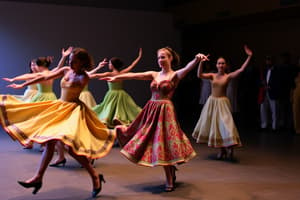Podcast
Questions and Answers
What was one of the primary purposes of early dances?
What was one of the primary purposes of early dances?
- To entertain the wealthy
- To perform in theatre shows
- To celebrate important events (correct)
- To improve physical fitness
Which category of dance is primarily aimed at pleasing the dancers themselves?
Which category of dance is primarily aimed at pleasing the dancers themselves?
- Theatrical dancing
- Ceremonial dances
- Social dancing (correct)
- Spiritual dances
What is a characteristic of Asian dance forms?
What is a characteristic of Asian dance forms?
- Contemplative and often religious in nature (correct)
- Strong influence from Western styles
- Emphasis on competition
- Focus on physical fitness
How did Greeks incorporate dance into their culture?
How did Greeks incorporate dance into their culture?
What was the nature of the pantomime in the Roman Empire?
What was the nature of the pantomime in the Roman Empire?
Which of the following was a prevalent dance during the Middle Ages?
Which of the following was a prevalent dance during the Middle Ages?
Greek dance was closely connected to which art forms?
Greek dance was closely connected to which art forms?
What role did the moresca play in dance history?
What role did the moresca play in dance history?
What type of dance often characterized Greek comedies?
What type of dance often characterized Greek comedies?
In what way was dance regarded in ancient Greece?
In what way was dance regarded in ancient Greece?
Study Notes
Origins of Dance
- Dance is among the oldest forms of human expression, rooted in prehistoric times.
- Early dances served practical purposes: appeasing nature, honoring deities, and celebrating events like births, harvests, and marriages.
- Cultural variations exist in dance, yet all utilize human body movement.
Classification of Dances
- Dances are categorized into three main types based on intent:
- Social dancing aims to please the dancers personally.
- Spiritual, religious, or ceremonial dances are performed to honor the gods.
- Theatrical dancing focuses on pleasing an audience.
- Many dances may fit into multiple categories at once.
Dance in Asian Cultures
- Asian dance often has religious ties and may be contemplative.
- Indian dance features elaborate movements, addressing a range of body parts often overlooked in Western styles.
- Japanese forms like Noh and Kabuki incorporate dance with other performing arts.
- Traditional Chinese theatre merges dance with acting, singing, juggling, and acrobatics.
Dance in Ancient Greece
- Dance was perceived as divine, integral to religion, education, and theatre.
- Philosophers like Plato conceptualized the universe's order through choreographic imagery.
- Dance was linked to the Muses, particularly Terpsichore, and gods such as Apollo and Dionysus.
- Greek dance intertwined with poetry and music, allowing rhythmic body movements to interpret poems.
- Originated mostly in Crete, Greek dances included vigorous male performances, religious circle dances, and those linked to mystic cults.
- The dithyramb, a simultaneous song-and-dance performance, influenced the development of tragedy and comedy.
- Notable dances include the pyrrhic, gymnopaedia, and hyporchema.
Dance in Greek Theatre
- Greek tragedies featured a combination of speech, song, chanting, and choreography.
- Emmelia dance provided enhanced theatrical action through stately movements and expressive gestures.
- Comedy showcased lively, often risqué dance forms such as the kordax.
- Dance was also a component of entertainment at social gatherings called symposiums.
Dance in the Roman Empire
- Expansion of the Roman Empire distanced dance from other art forms like poetry.
- Pantomime, where a solo performer represented all characters in a story, gained popularity.
- Some forms of entertainment involved aggressive elements, leading to condemnation by early Christian moralists.
Dance in the Middle Ages
- Dance held significance for both nobility and commoners during the Middle Ages.
- Public celebrations organized by guilds featured various dance types, including processional and social dances.
- Medieval dance included both vocal and instrumental styles, such as ductia, stantipes, estampie, round, and carol.
- The moresca emerged in the 12th century as a lively dance form, achieving widespread popularity across Europe for centuries.
Studying That Suits You
Use AI to generate personalized quizzes and flashcards to suit your learning preferences.
Description
Explore the rich history of dance as one of the oldest forms of human expression. From early practices aimed at appeasing nature and honoring deities to celebrations of life's milestones, discover how dance varies across cultures. This quiz will also delve into the classification of dances based on their characteristics.




